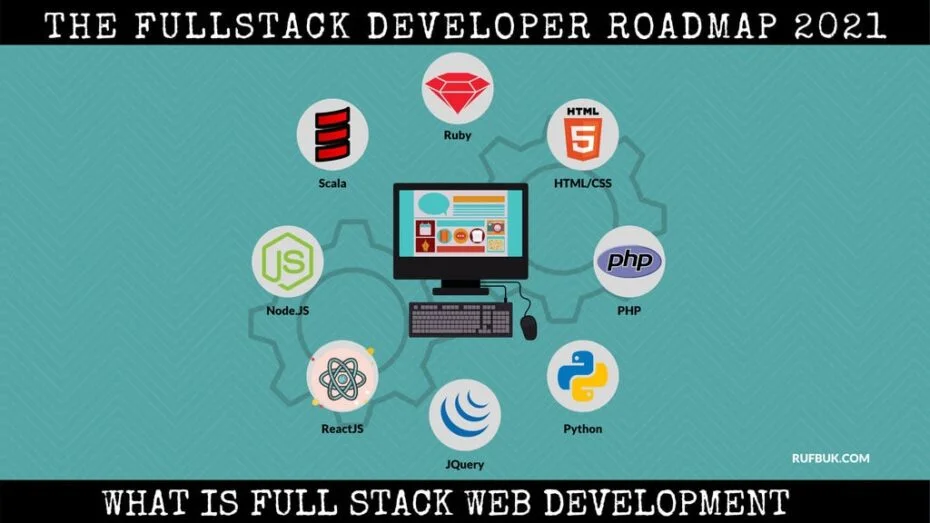Table of Contents
Web Development is a promising field with various growing job opportunities. Every minute, multiple websites are created, increasing the opportunities to a great range. Every year, new methods and frameworks come and make the field more promising and exciting. This article tried to provide The Full-stack Web Developer Roadmap that you should consider in your Full stack web developer journey.
What is Web Development?
Web development involves the task of building and maintaining the website. It is the task to make the website look good, perform well, and provide a user-friendly experience. Multiple programming languages on a large variety of platforms are used for Web Development. It is the most demanding, well-paid, and skilled work that makes it a good and exciting career option. Web Development can be divided into two parts: Front end and Back end.
Who is a Full-stack Developer?
In simple words, the person responsible for creating and maintaining the website’s Front end is known as a Front end Developer, website back end is created and maintained by a Back end Developer, and the person who has qualities of both Front end and Back end developer is known as Full-stack Developer.
Read about EdTech Companies in India
Full Stack Web Development Roadmap
Full-stack Web Development can be quickly learned by following a Two-Phased method. The first phase involves the Front end, and another Phase consists of the back end.
Front-end
It is the user side or user interface of any web application. It is the side through which the user interacts. It consists of:
- HTML
- CSS
- JavaScript
HTML: HTML stands for Hypertext Markup Language. It is a standard markup language for web browser documents. It is designed to display web browser documents on web browsers.
HTML involves a variety of elements. It is the skeleton of the web page. At the initial level, one should learn HTML to the extent that he/she can build the required page layout without any hurdles.
CSS: Cascading Style Sheets assist in representing an HTML document and determines the design of a web page.
As with any other language, this style sheet language does have multiple properties for a particular element. At the initial level, one should learn CSS to the extent that he/she can efficiently work with color, background, padding, class, id, and the margin of the elements.
JavaScript: JS is a web programming language that enables the programmer to create a dynamically updating webpage.
JavaScript determines the logic or working of elements of the webpage. At the initial level, one should learn JavaScript to the extent that he/she can work with variables, functions, and loops.
Note: Java and JavaScript are different.
Back-end
The back-end is the server-side of a web application and is termed the powerhouse of any web application.
When it comes to the back end, we have multiple options to work with. Choosing PHP, NodeJS, or Python will be the right choice.
PHP: PHP is a general-purpose server scripting language that is well suited to web development.
PHP is recommended as it is fast and is easy to learn for beginners, and its syntax is much related to JavaScript, which is already known for the Front end. Along with PHP, MySQL should be the right choice as a database.
Node.js: Node.js is an open-source server environment that runs on multiple platforms and uses JavaScript on the server.
If not PHP then, Node.js will be the right choice, but it is a little complicated but is suitable for those who enjoy working with JavaScript. Along with Node.js, MongoDB will be an excellent choice to work with.
Python: Python is an interpreted, high-level, structural/procedural, object-oriented, functional programming and general-purpose language which can also be used to create server-side web applications.
Working with python as a back-end language could be a time-consuming and hectic task for beginners. Along with Python, SQLite should be the right choice as a Database.
Tips for full-stack web development
One should brush up on his knowledge of concepts by applying them to various projects. It will help the individual to learn while working.
Many beginners make a common mistake of using frameworks(already developed code for a particular task), website builders, or third-party libraries at their initial level that is not the right approach. At the initial level, one should learn the concepts, their application and build autonomously to master the field of full-stack web development successfully.
Job Opportunities in the Full-Stack Web Development
A web developer can easily earn through placements, freelancing, or by doing projects.
When it comes to average salaries, a front-end developer could easily earn from 5 to 7 Lakhs per annum, 8 to 10 Lakhs per annum for a back-end developer, and more than 10 Lakhs per annum for full-stack web development.
Explore job opportunities for full-stack web development at Glassdoor.

